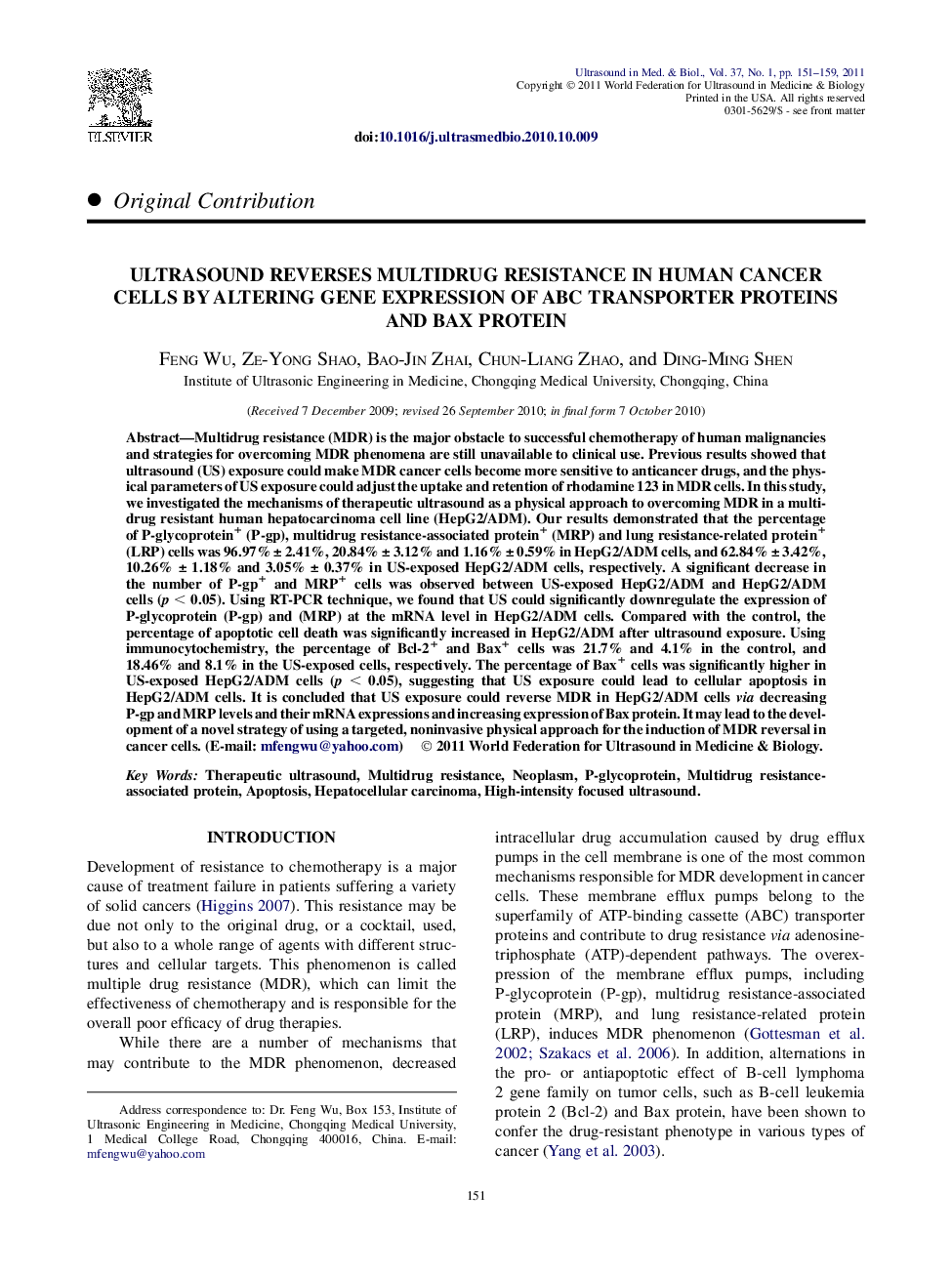| کد مقاله | کد نشریه | سال انتشار | مقاله انگلیسی | نسخه تمام متن |
|---|---|---|---|---|
| 1761101 | 1019633 | 2011 | 9 صفحه PDF | دانلود رایگان |
عنوان انگلیسی مقاله ISI
Ultrasound Reverses Multidrug Resistance in Human Cancer Cells by Altering Gene Expression of ABC Transporter Proteins and Bax Protein
دانلود مقاله + سفارش ترجمه
دانلود مقاله ISI انگلیسی
رایگان برای ایرانیان
کلمات کلیدی
P-glycoprotein - P-گلیکوپروتئینApoptosis - خزان یاختهایTherapeutic ultrasound - سونوگرافی درمانیHigh-intensity focused ultrasound - سونوگرافی متمرکز با شدت بالاMultidrug resistance - مقاومت چند داروییNeoplasm - نئوپلاسمmultidrug resistance-associated protein - پروتئین مرتبط با مقاومت چند داروییHepatocellular carcinoma - کارسینوم هپاتوسلولار(کارسینوم سلولهای استخوانی)
موضوعات مرتبط
مهندسی و علوم پایه
فیزیک و نجوم
آکوستیک و فرا صوت
پیش نمایش صفحه اول مقاله

چکیده انگلیسی
Multidrug resistance (MDR) is the major obstacle to successful chemotherapy of human malignancies and strategies for overcoming MDR phenomena are still unavailable to clinical use. Previous results showed that ultrasound (US) exposure could make MDR cancer cells become more sensitive to anticancer drugs, and the physical parameters of US exposure could adjust the uptake and retention of rhodamine 123 in MDR cells. In this study, we investigated the mechanisms of therapeutic ultrasound as a physical approach to overcoming MDR in a multidrug resistant human hepatocarcinoma cell line (HepG2/ADM). Our results demonstrated that the percentage of P-glycoprotein+ (P-gp), multidrug resistance-associated protein+ (MRP) and lung resistance-related protein+ (LRP) cells was 96.97% ± 2.41%, 20.84% ± 3.12% and 1.16% ± 0.59% in HepG2/ADM cells, and 62.84% ± 3.42%, 10.26% ± 1.18% and 3.05% ± 0.37% in US-exposed HepG2/ADM cells, respectively. A significant decrease in the number of P-gp+ and MRP+ cells was observed between US-exposed HepG2/ADM and HepG2/ADM cells (p < 0.05). Using RT-PCR technique, we found that US could significantly downregulate the expression of P-glycoprotein (P-gp) and (MRP) at the mRNA level in HepG2/ADM cells. Compared with the control, the percentage of apoptotic cell death was significantly increased in HepG2/ADM after ultrasound exposure. Using immunocytochemistry, the percentage of Bcl-2+ and Bax+ cells was 21.7% and 4.1% in the control, and 18.46% and 8.1% in the US-exposed cells, respectively. The percentage of Bax+ cells was significantly higher in US-exposed HepG2/ADM cells (p < 0.05), suggesting that US exposure could lead to cellular apoptosis in HepG2/ADM cells. It is concluded that US exposure could reverse MDR in HepG2/ADM cells via decreasing P-gp and MRP levels and their mRNA expressions and increasing expression of Bax protein. It may lead to the development of a novel strategy of using a targeted, noninvasive physical approach for the induction of MDR reversal in cancer cells. (E-mail: mfengwu@yahoo.com)
ناشر
Database: Elsevier - ScienceDirect (ساینس دایرکت)
Journal: Ultrasound in Medicine & Biology - Volume 37, Issue 1, January 2011, Pages 151-159
Journal: Ultrasound in Medicine & Biology - Volume 37, Issue 1, January 2011, Pages 151-159
نویسندگان
Feng Wu, Ze-Yong Shao, Bao-Jin Zhai, Chun-Liang Zhao, Ding-Ming Shen,